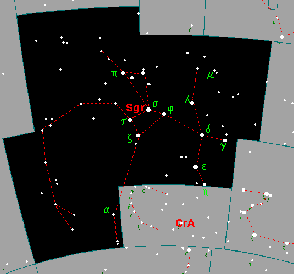
![[de]](../../Logos/flag_ger.gif)
![[it]](../../Logos/flag_it.gif)
IX. sign of zodiac
Particulars:
General:
Ninth sign of the zodiac. The sun passes through this constellation from late
December to late January, so it is best viewed in the nights of summer time.
This constellation is certainly worth random scanning with low power scopes as
well as intense investigations of the single objects. Not only there are lots
of rich star fields towards the galactic center, there a numerous clusters and
nebulae.
In the center of this constellation lies the conspicious
asterism the Milk
Dipper (it seems that it is sometimes called "The Teapot").
It lies in the beautiful star clouds of the southern Milky Way.
Some of stars have common names. See here
a list of them.
Stars and other objects
The binary zeta Sgr (b 51) cannot be resolved by amateur scopes. Just
one star of 2.6 mag can be seen. Largest telescopes are required to split this
close double of an A2 giant and an A4 subgiant. The two stars revolve each
other in 21 years.
21 Sgr is a test for a telescope with an aperture of 80 mm. It might
need an aperture of at least 100 mm to split 21 Sgr into its components.
The interesting orange-green pair has magnitudes of 5.0 and 8.3.
Some Cepheid variable stars can be found in this constellation:
W Sgr is a supergiant which brightness fluctuates every 7 days and 14
hours between 4.4 mag and 5.0 mag.
The supergiant (spectraltype G1.5Ib) U Sgr lies close to center of
M25. The brightness of this Cepheid
varies from 6.3 mag to 7.1 mag every 6 days and 18 hours.
X Sgr is a F2 bright giant. Its brightness varies from 4.3 mag to 4.9
mag every 7 days.
To the naked eye beta Sgr seems to be a double star. The both stars, a
B9 main sequence star of 4,01 mag and a F2 giant of 4.29 mag, are not a real
binary (no physicale relation). Viewed through a small scope the more northerly
star, beta1 Sgr shows a 7th mag companion.
The Sagittarius Star Cloud or Delle Caustiche,
M 24, is not a real deep sky
object, but a large star field; it is a part of our Milky Way. The naked eye it
appears as a foggy patch, larger scopes reveal a breathtaking star cloud.
The famous Lagoon Nebula, M8,
is probably the best of the diffuse nebula and one of the finest in the sky. As
it is of 6th mag the naked eye can see it in a dark night. Binoculars and small
telescopes reveal an open cluster within that nebula,
NGC 6530. Viewed
with scopes with an aperture of at least 75 mm the dark lane of dust, which
gave the name to the nebula, is revealed. The color and the internal structures
can only seen on photographs.
The diffuse nebula M 17 has lots of
names. It is known as Omega, Swan, Horseshoe or Lobster
Nebula. In small scopes the nebula appears like the tail of a comet.
At one side some stars are sprinkling. They build a mini cluster and belong to
the nebula. Larger telescopes reveal a looped shape.
The last of the three diffuse nebulae, M20,
called Trifid Nebula, got its name from the three dust lanes,
which divide the nebula. This structure can only be seen with large telescopes.
Small scopes just show the bright stars in the heart of the nebula.
The planetary nebula NGC6818 shows an irregular oval shape.
The open star cluster M 18 appears
loose for the 20 cluster members a scattered over a region of 0.2 degrees in
the sky. Therefore its best viewed with binoculars or small scopes.
M 21 appears to be the opposite of
M18; it shows a quite strong concentration towards its center
M 23 is an excellant object for
binoculars. The open cluster nearly covers 0.5 degrees of the sky. With small
scopes some the about 100 cluster members can be resolved.
About 50 stars of 6th mag and fainter build the cluster
M 25. It is a good object for
binoculars.
NGC 6530 is a binocular cluster
of about 25 stars of 7th mag and fainter. It is located in the
Lagoon Nebula.
The globular cluster M22 might be the
first globular cluster discovered. As it is even brighter as the famous
Hercules Globular Cluster, M13,
it can be seen with the naked eye. It should be noted that this cluster lies
less that 1 degree of the ecliptic; therefore conjunctions with planets can be
observed quite frequently.
Close to zeta Sgr the globular M54
is located. Although it is bright smaller binoculars may overlook it because it
is so dense that it looks like a star. In 1994 the discovery was made that this
cluster does not belong to our galaxy but to the
Sagittarius Dwarf
Elliptical Galaxy.
A large, but loose globular cluster is M55.
It can be viewed with binoculars.
For details about M28,
M69,
M70 and
M75 (as well as for all other Messier
objects) please take a look at the Messier database.
At the very edge of Sagittarius, at the border to
Ophiuchus and
Scorpius lies the center
of our galaxy. It lies about 30000 lightyears distant.
From June, 8th, till June 16th, the Sagittariids
are active. This shower was detected 1957/8 during radio-echo surveys. The
maximum occurs around June, 10th and 11th. The average radiant is DECL=-34 deg
and RA=304 deg.
The Phi Sagittariids
can be observed from June, 1st, to July, 15th. It shows a weak maximum on June,
18th. This shower seems to renamed recently to
Scorpiids-Sagittariids.
The Capricornids-Sagittariids
are a daylight shower and can be observed from Mid-January to February.
Mythological Background:
![[Constellations]](../../Logos/constS_s.gif)
![[Home]](../../Logos/maa_s.gif)